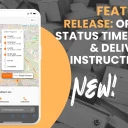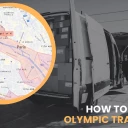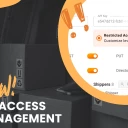How Effective Is MapQuest for Commercial Delivery Routing?
Updated on
March 04, 2024
by
Mike Foster
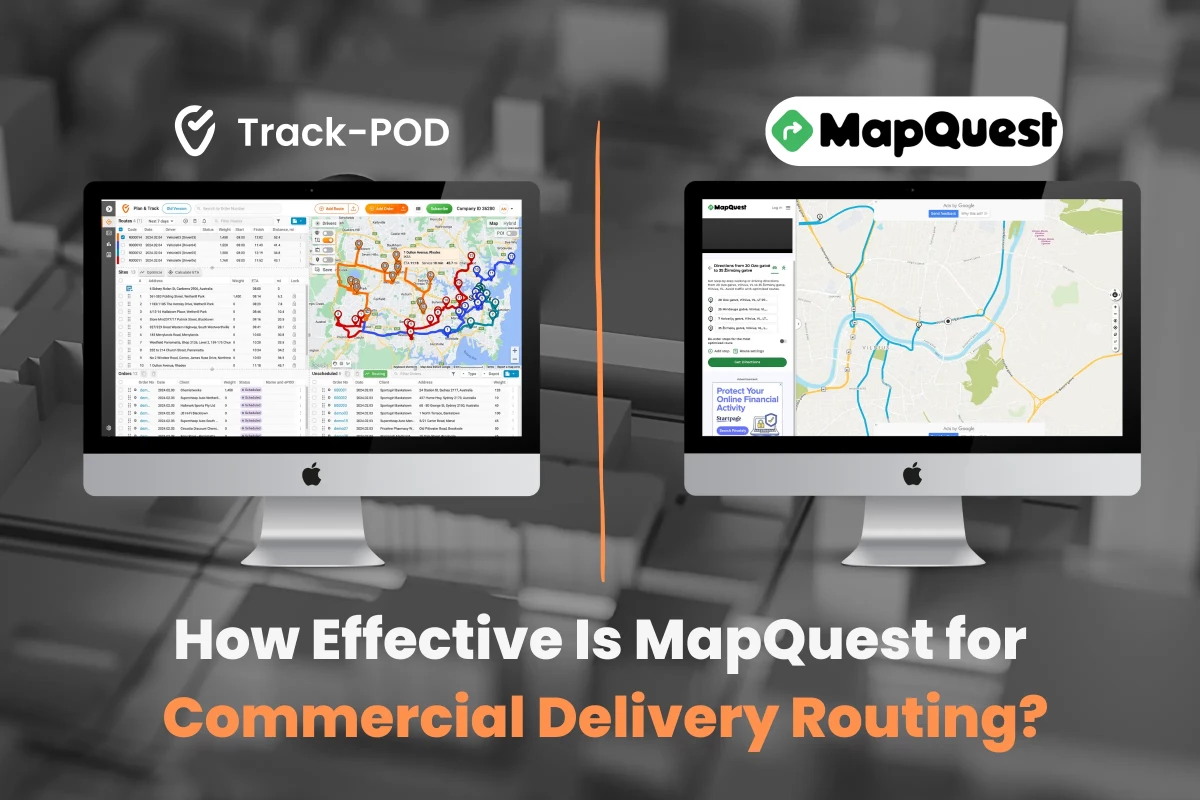
In the commercial delivery industry, planning optimized routes goes a long way in terms of timely deliveries and cost savings. This also leads to reduced fuel consumption, minimized vehicle wear and tear, and, ultimately, happier customers, all of which demand software integration into your business landscape.
However, finding the right routing tool that handles multiple stops and ensures efficient deliveries is no easy feat, with multiple mediocre options available.
Here comes the role of MapQuest, which stands out as a widely recognized routing solution.
Its intuitive interface and robust specifications make it an ultimate choice for businesses looking to streamline their delivery operations. But how effective is MapQuest in practice?
Studies have shown that 4,599 live websites utilize MapQuest to find the best routes for smooth and effective delivery schedules.
In this article, we will explore how MapQuest, as a free tool, is transforming the way businesses approach logistics and its best alternative that brings advancement in digital routing solutions.
Overview of MapQuest for delivery routing
MapQuest is a useful free tool, as it provides unique features for delivery routing. However, compared to dedicated commercial route planning optimization software, MapQuest often lacks the most basic functionality necessary for efficient logistics management.
Let's take a closer look at its capabilities for a better idea.
MapQuest multiple-stops route planning
MapQuest's multi-stop route planning feature is essential for users who must navigate multiple destinations efficiently. Users can input up to 26 stops in a single session, allowing for relatively complex routing needs to be addressed.
However, one limitation of MapQuest is that it only allows planning for a single route per session, which may be a drawback.
Optimization algorithms
MapQuest route planner app is like having a super-smart assistant for delivery routes. It helps you find the most suitable sequence of stops along the delivery route through its vast database.
Additionally, MapQuest facilitates drivers and logistic planners to speed up the process and reduce travel duration by providing real-time insights on distance, time constraints, and more. It leads to prompt deliveries and lower operational expenses, satisfying customers simultaneously.
Interactive map features
MapQuest presents interactive map features that empower users to seamlessly navigate their surroundings, locate nearby amenities, and pinpoint points of interest along their journey. With distinctive capabilities and the option to search for particular businesses or landmarks, users can effortlessly enhance their exploration experience.
These interactive tools enrich the user experience and offer invaluable assistance in navigating with ease and assurance.
Customization options
MapQuest offers a range of customization options to suit individual preferences and business needs. Users can tailor route settings based on preferred road types and avoidance of tolls or ferries.
This flexibility allows businesses to optimize delivery routes according to specific requirements, maximizing efficiency and minimizing unnecessary detours.
General functionality of the MapQuest app
Let's take a closer look at the general functionality of the MapQuest web-based app:
- User-friendly interface: the buzz surrounding MapQuest mainly stems from its user-friendly design, enabling users to input addresses, customize preferences, and generate optimized routes with ease, all through a few simple taps.
- Map customization: while limited compared to competitors, you can adjust map types for better personalization.
- Search filters: refine your POI searches by category (restaurants, gas stations, etc.), cuisine type, price range, and user ratings for targeted results.
- Speed limits: view posted speed limits along your route, aiding in safe and responsible driving.
- Estimated arrival time (ETA) accuracy: users generally report reliable ETAs, which is helpful for planning journeys and appointments.
Challenges of using MapQuest for commercial deliveries
While MapQuest offers valuable features for commercial deliveries, it comes with certain limitations that are as follows:
No live tracking feature
A notable hurdle in using MapQuest for commercial deliveries is the lack of live driver tracking.
This critical feature allows businesses to maintain real-time visibility into their drivers' locations, which is pivotal for operational efficiency and customer satisfaction.
Without this feature, promptly addressing issues like delays or route deviations becomes challenging, potentially disrupting delivery schedules and compromising service quality.
No delivery notifications or load planning tools
MapQuest presents challenges in providing delivery notifications to customers and implementing barcode/QR scanning for load planning.
These features are essential for modern delivery operations to ensure transparency and efficiency. Without robust notification capabilities, customers may experience uncertainty regarding their deliveries, leading to dissatisfaction.
Similarly, the absence of barcode/QR scanning functionality hampers load planning accuracy, making it difficult to track and manage inventory effectively throughout the delivery process. These limitations can result in logistical inefficiencies and potentially impact customer service standards.
No ePOD
Ensuring accountability and transparency in commercial delivery operations is imperative. Well, this is no longer an issue with the emergence of electronic proof of delivery (ePOD).
However, MapQuest faces significant challenges in this regard due to the absence of a dedicated mobile application. Without this essential tool, functionalities such as signature capture, photo-taking for documentation, and PIN entry for secure verification are unavailable.
As a result, businesses relying on MapQuest for delivery operations may struggle to gather crucial proof of delivery data, impacting customer satisfaction.
These limitations indicate the need for alternative solutions with comprehensive mobile capabilities for seamless ePOD management.
No process optimization or communication tools
While MapQuest is renowned for its navigation prowess, it lacks the necessary tools to optimize delivery efficiency. The absence of advanced analytics and seamless route transfer mechanisms poses significant challenges for businesses aiming to streamline their operations.
As a result, MapQuest users may find themselves grappling with inefficiencies and missed opportunities for process enhancement.
Not possible to handle dynamic changes
In the busy world of commercial deliveries, things can instantly switch up. Whether it's adding a new stop to the delivery list or suddenly running into unexpected road problems, MapQuest might struggle to keep up with these sudden changes as they happen.
That’s because MapQuest allows only to plan routes in advance. In order to make any iterations, users need to create new routes from scratch.
This could lead to less efficient routes, missing chances to make things run smoother, and, in the end, causing irregularities in the delivery process.
Advertisement interruptions
In MapQuest's free version, advertisements pop up, which can be troublesome for users, especially when navigating crucial points.
For commercial delivery drivers who need to stay focused on efficient and safe navigation, these interruptions can get in the way and cause them to miss turns or get confused.
Although premium versions of the app don't have ads, some businesses with tight budgets might find it hard to justify the extra cost.
Meet Track-POD, the ultimate multi-stop delivery routing solution
MapQuest's limitations become particularly evident in multi-stop routing scenarios, where it struggles to optimize routes with numerous destinations efficiently. This can result in suboptimal sequences, unnecessary detours, and longer overall delivery times.
Here, Track-POD emerges as a premier alternative to traditional route planner apps like MapQuest, specifically tailored to meet the demands of multi-stop delivery routing. Let's dive into the underlying specs to know how they revolutionize modern-day businesses.
Advanced multi-stop route optimization
Track-POD excels in optimizing routes with multiple stops, leveraging sophisticated algorithms to calculate the most efficient sequence of deliveries. This automation saves precious time and manual effort for other pressing tasks while ensuring accuracy every step of the way.
Real-time tracking and monitoring
With Track-POD, businesses gain real-time visibility into their delivery fleet's whereabouts and performance. It ensures integrated GPS tracking capabilities that allow for precise monitoring of driver locations, enabling companies to proactively mitigate any delays or issues that may arise during delivery operations.
Related Read: How-to: Driver Time Record w/o Extra Devices | Track-POD
Electronic proof of delivery (ePOD)
It also simplifies the delivery confirmation process with its electronic proof of delivery feature. Drivers can capture signatures, photos, and other relevant data directly within the app, eliminating the need for paper-based documentation and streamlining business administrative tasks.
Dedicated customer support
Track-POD offers ultimate customer support to help businesses at every step. Whether you're just starting, getting everything set up, or dealing with any problems later on, Track-POD's team is here to help.
They're dedicated to giving excellent service and making sure you have an easy time using their platform.
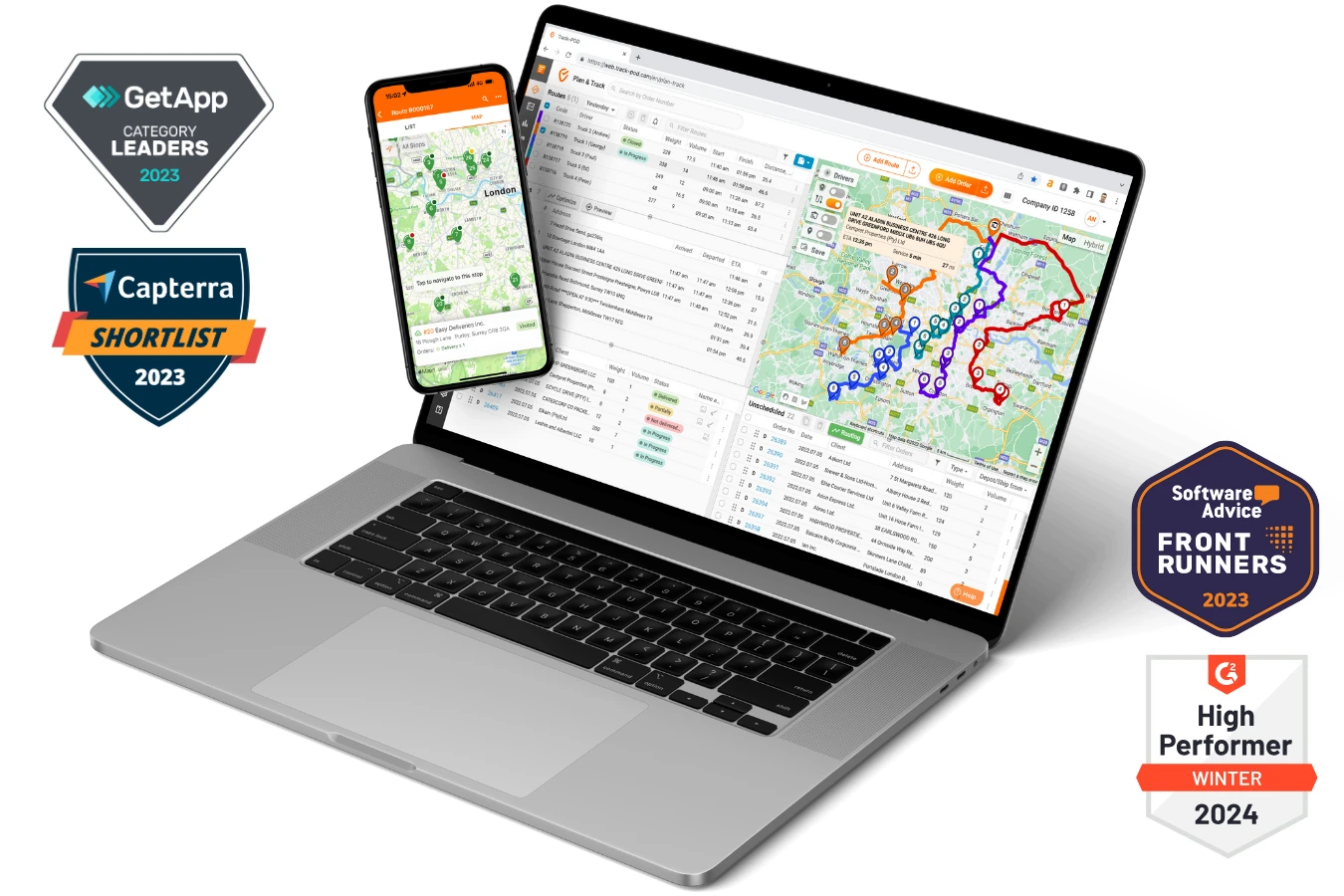
MapQuest vs. Track-POD: A comparative analysis
Comparing MapQuest and Track-POD provides insights into their respective features, usability, and suitability for various navigation and logistics needs. Below, we have discussed the underlying parameters that offer a comprehensive distinction between both.
Functionality
Regarding functionality, both MapQuest and Track-POD offer solutions tailored to commercial delivery operations, but they diverge in depth and sophistication. MapQuest provides a solid foundation for route planning and navigation, with features like MapQuest multiple stops route optimization that supports 26 addresses per route. Also, the interactive map features work well for locating points of interest.
However, its capabilities may be more basic than Track-POD, which goes beyond minimal route planning and offers unlimited stops for the most efficient delivery sequences. Additionally, while MapQuest calculates the most efficient route for a single driver per session, Track-POD provides the flexibility to create routes for multiple drivers simultaneously, making it suitable for scheduling deliveries in advance and optimizing logistics for more extensive operations.
While effective, MapQuest's route optimization algorithms may not offer the same level of granularity and customization as Track-POD. This potentially leads to suboptimal routes in complex delivery scenarios.
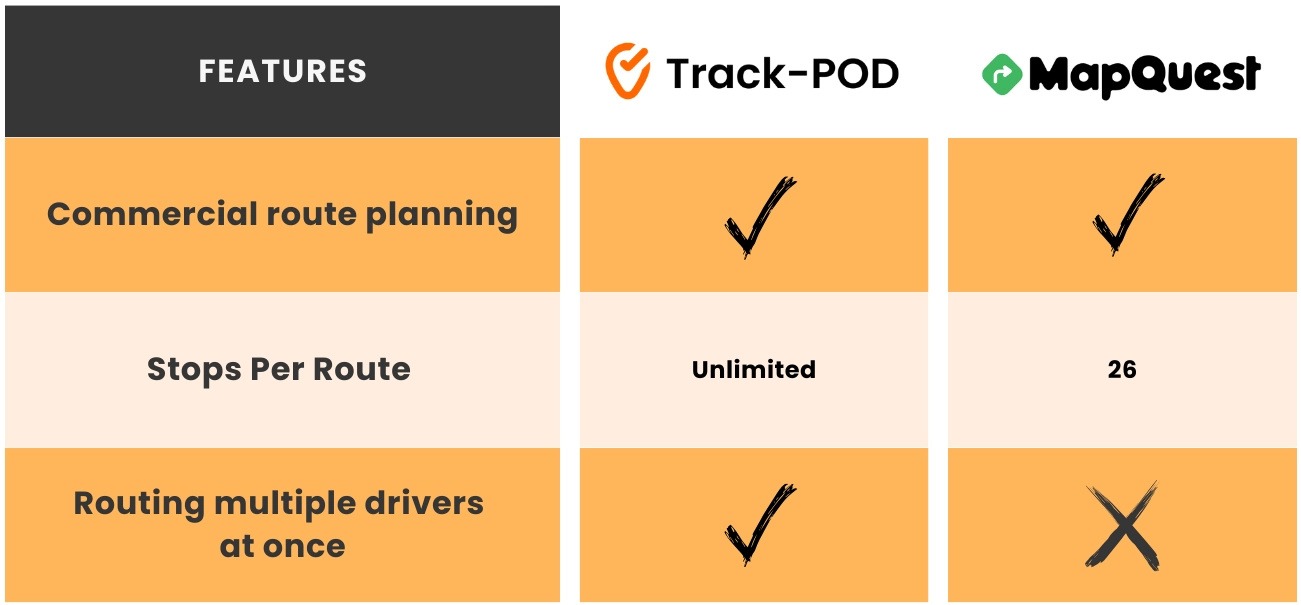
Efficiency
When it comes to efficiency, MapQuest and Track-POD present distinct approaches. MapQuest offers detailed maps, plans the best routes, and gives real-time updates about traffic and points of interest.
While these features contribute to improved efficiency compared to manual route planning methods, MapQuest lacks advanced optimization algorithms and detailed analytics.
In contrast, Track-POD sets itself apart by maximizing efficiency through advanced functionality tailored for commercial delivery needs. The platform offers multi-stop route optimization with professional features, including delivery time windows and GPS real-time tracking capabilities to support small businesses for efficient delivery operations.
Additionally, Track-POD's electronic proof of delivery feature streamlines administrative tasks and enhances accountability, further contributing to overall efficiency gains.
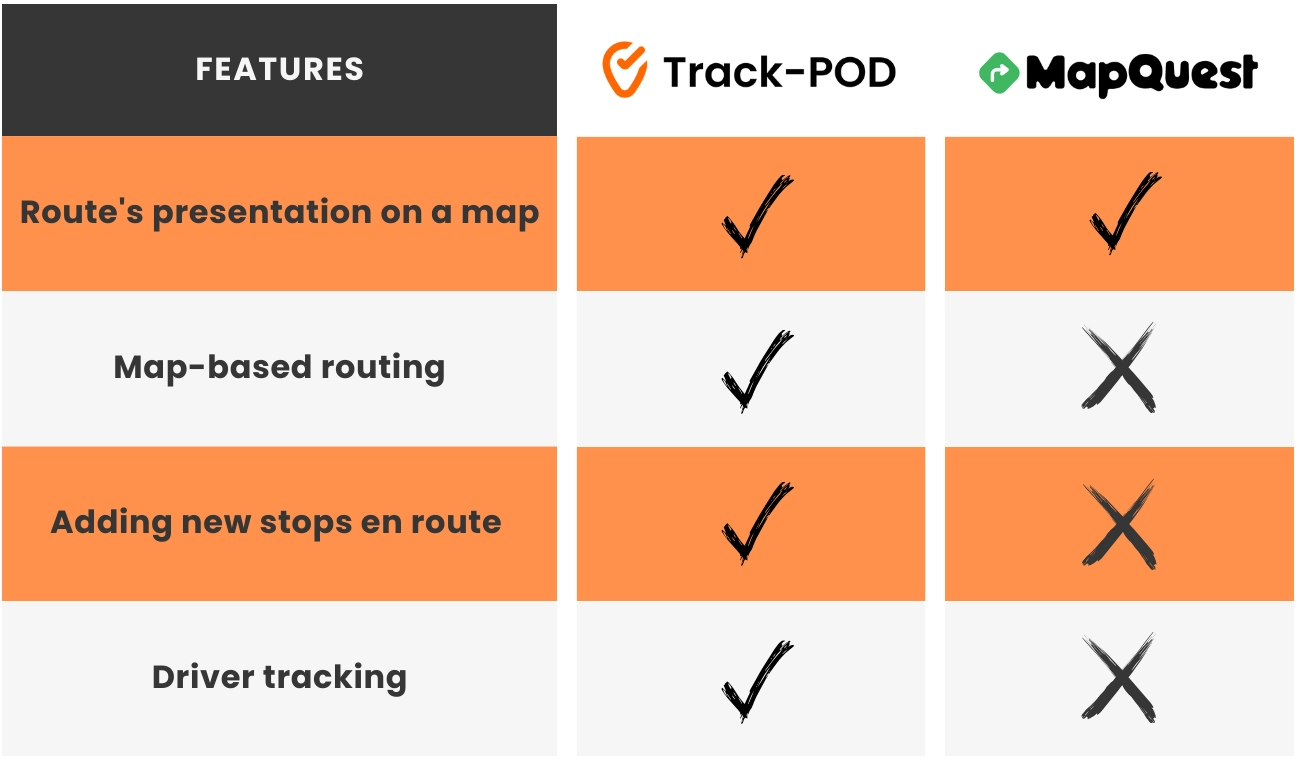
Ease of use
While both software offers user-friendly interfaces, MapQuest maintains a more generalized approach, focusing on providing a straightforward navigation experience for a diverse user base.
Its interface may feel familiar to users who go with traditional mapping services, offering intuitive input options and standard navigation controls.
Conversely, Track-POD's emphasis on delivery logistics means its interface is tailored specifically for professionals in this field. It streamlines the process of inputting multiple delivery locations, optimizing routes, and managing logistics workflows.
While still intuitive, Track-POD may require a slightly steeper learning curve for users unfamiliar with its specialized features and terminology.
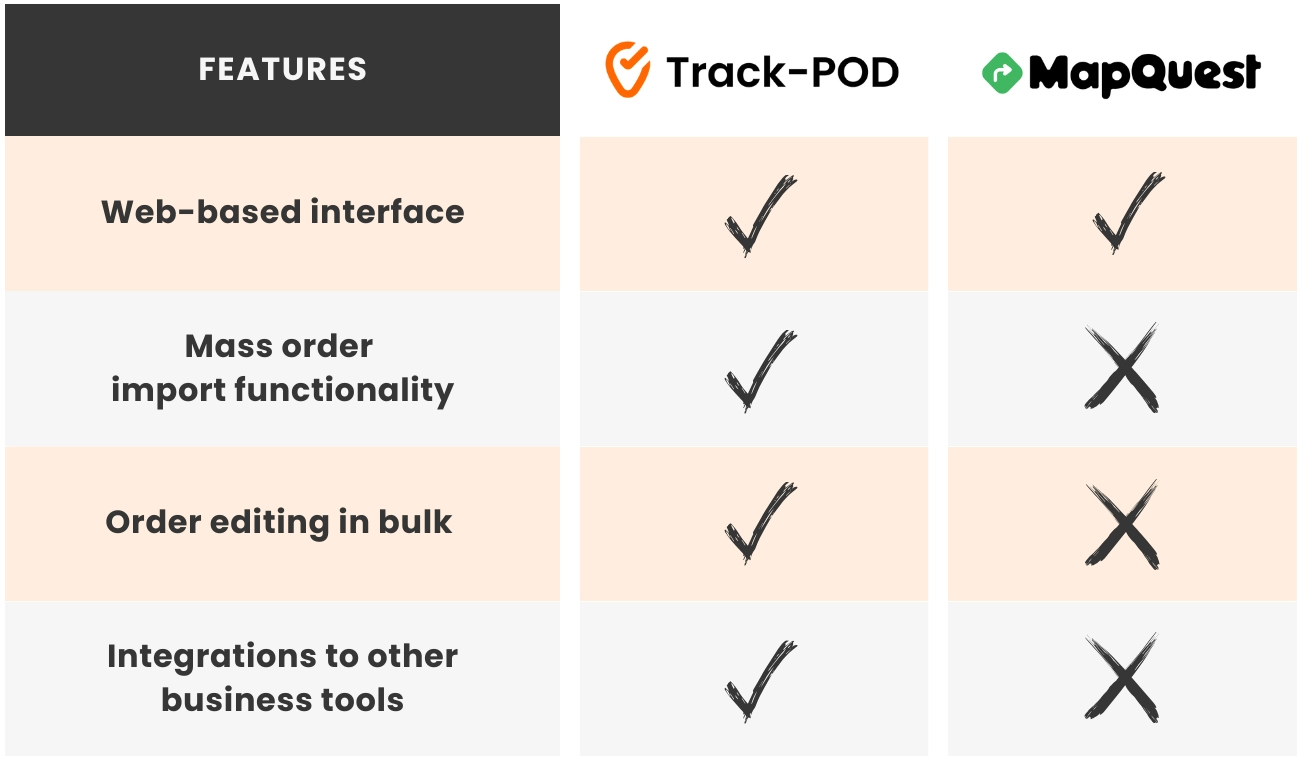
Scalability
MapQuest primarily targets individual driver navigation and route optimization needs, making it a suitable choice for smaller-scale operations.
However, it falls short when it comes to addressing the complex requirements of enterprise fleet management. MapQuest lacks features tailored explicitly for tasks such as multi-depot planning, advanced stop optimization, and customized reporting.
On the other hand, Track-POD is purposefully designed for enterprise fleet management, offering a comprehensive suite of tools that seamlessly scale with business growth.
Track-POD's focus on enterprise needs is evident in its robust features that support complex operations, accommodate larger fleets, and provide real-time analytics to adapt to evolving market demands.
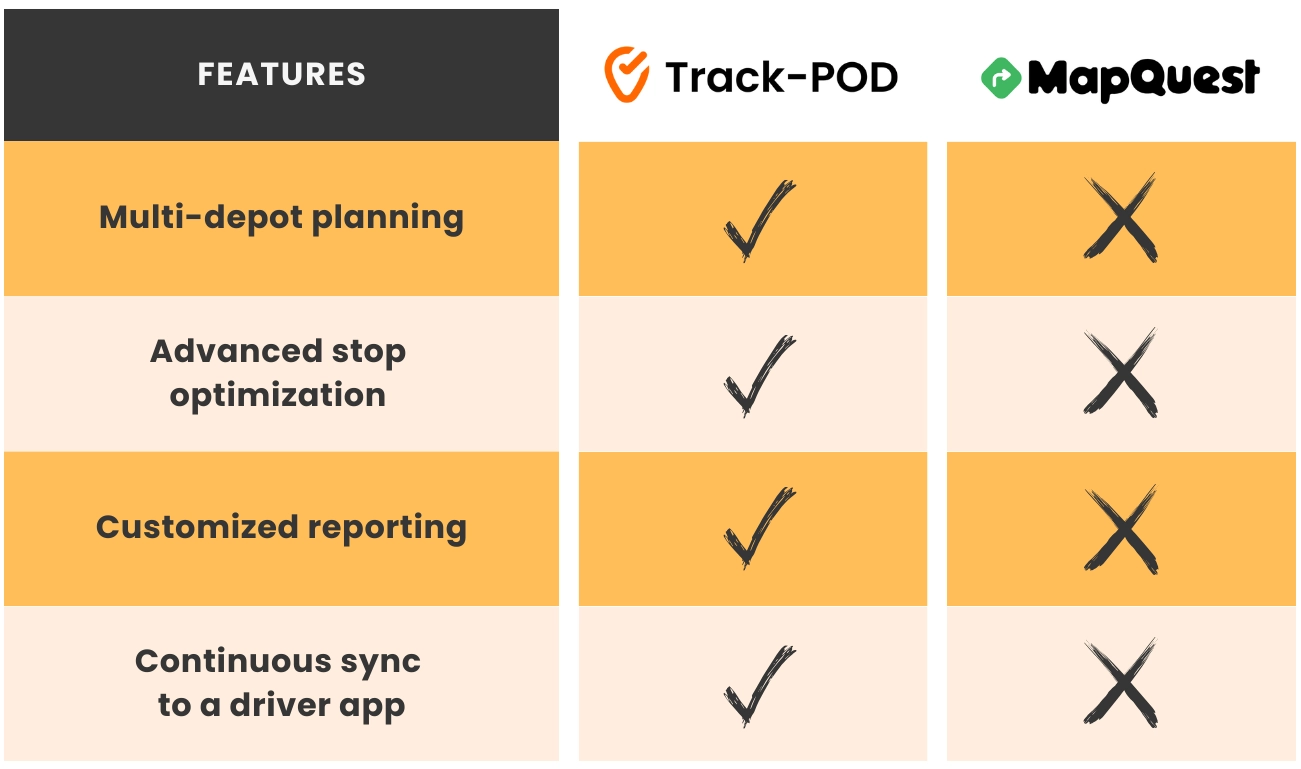
MapQuest vs Track-POD: the verdict
Introducing specialized tools like Track-POD over more general solutions like MapQuest offers a strategic advantage for businesses seeking to optimize their delivery operations.
Let's witness how it can be the best investment for efficient delivery management below.
1. Comprehensive operational optimization: beyond route planning, Track-POD enables businesses to streamline their entire delivery operations, from dispatch and routing to proof of delivery and performance monitoring.
2. Integration capabilities: Track-POD seamlessly integrates with various business systems such as ERP and CRM, facilitating streamlined workflows and efficient data exchange. This integration enhances operational efficiency by providing a centralized platform for managing delivery operations and integrating with other essential business processes.
3. Real-time visibility and control: Track-POD offers robust reporting tools to analyze trends, identify inefficiencies, and optimize operations continuously. By gaining valuable insights into fleet performance, businesses can easily monitor driver behavior, track vehicle locations, and respond promptly to unexpected events or delays.
With the increasing complexities in scheduling time and delivery management, the choice of the most suitable software is the building block of business success.
While MapQuest serves well for individual navigation, Track-POD emerges as the clear winner for routing efficiency and operational optimization in fleet management.
Its specialization, advanced algorithms, deeper visibility, and industry-specific features translate into tangible benefits like cost savings, improved delivery times, and enhanced operational efficiency. Ultimately, the choice goes down to your specific needs and priorities.

